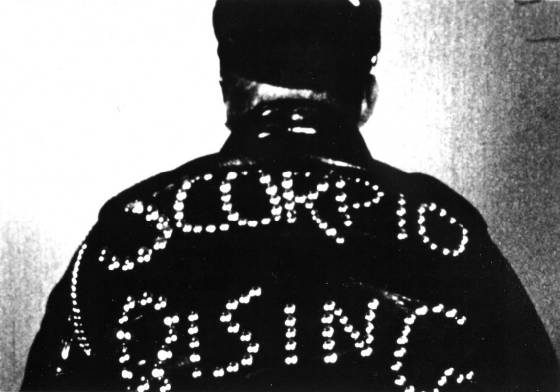|

(1963, directed by Kenneth Anger)
- inducted 2018 –
“In Kenneth Anger's 1949 short Puce Moment, a silent film actress lovingly flips through a rack of multicolored
gowns. She chooses one, then applies perfume, and prepares to go out. Anger captures the solitary pleasures of assembling
a persona, focusing on the reverie of the ritual. With Scorpio Rising, Anger once again begins by again fetishizing
vanity, only shifting from feminine cultural codes to masculine ones. And shifting from the subjective p.o.v. of the silent
actress, to a more objective gaze onto the young Coney Island bikers. The camera watches as they assemble their custom bikes,
chrome additions glistening in Anger’s loving light. Angles are explicitly chosen for their ability to make an object
phallic.
“From building their bikes Anger moves to the men applying their rugged personae. Through Anger’s lens they appear
as Tom of Finland characters drawing themselves. During these preparatory scenes, the cinema is straightforward. Five songs
introduce five different bikers respectively, and the editing gives a clear sense of character and space as sixties pop songs
– “Fools Rush In,” “My Boyfriend’s Back,” etc. - dictate the tone and act as narration.
The final biker, Scorpio, is introduced reading comics, watching Brando in The Wild One, lounging beneath multiple
James Dean posters as “Devil in Disguise” plays on the soundtrack. This mise-en-scene reads a bit on-the-nose,
though the only element Anger added was the lighting...at least, according to Anger’s commentary; though this season
of You Must Remember This reminds us he is not always the most reliable narrator. Though, whether the decorations were
found or arranged, it’s not like subtlety has a place in films by Anger anyway.
“The second half essentially begins with Scorpio snorting mescaline. This act invokes a more expressive and subjective
techniques, as pop culture images are more rapidly juxtaposed with footage of men on bikes and stills from studio films. In
Puce Moment, the camera becomes more distant when the actress leaves. In Scorpio Rising it’s the reverse.
As the film careens to its ending, the editing becomes increasingly complex. The elegance and glamour found within individual
portraits transitions to fascism and violence as individual bikers come together and become a gang. Their identities literally
become lost under masks as they join together for a night of butch bacchanalia. Save for Scorpio, who emerges as a de facto
leader of the pack. Through montage he is linked to both Jesus, via footage from a Sunday School film (mistakenly delivered
to Anger during editing), and Hitler.
“Anger seems to be suggesting that, on their own, these men can be human, but once they get together, mob mentality
overtakes humanity. An hypothesis later evidenced by Anger’s befriending of Bobby Beausoleil, who then joined up with
the Manson Family and murdered Gary Hinman. Any zen found in motorcycle maintenance has been traded in for ephemeral pleasures
of group terror. The heightened danger is clear in the second half’s song titles as well: “Torture,” “Point
of No Return,” and finally “Wipeout.” The final race was filmed the day after the Halloween party. Anger
didn’t have a solid ending in mind while making the film, but when one of the bikers crashed, snapped his neck and died
right in front of the camera, he found it.
“Just before a leather strap slaps down into frame announcing, ’The End,’ Anger zooms in on the dead biker’s
forearm to a tattoo reading: Blessed Blessed Oblivion. Maybe he really meant it, and found blessed, blessed oblivion
doing exactly what he loved. Then again, maybe, in that final moment, he wished he had just stayed inside and worked on his
bike.”
~ Kevin Cecil
|
|
Screenplay by: Ernest D. Glucksman, Kenneth Anger (uncredited)
Produced by: Ernest D. Glucksman
Co-producer: Arthur P. Schmidt
Original music by: Jack Brooks, David Raksin
All other cast and crew not credited:
Principal cast: Ernie Allo, Bruce Byron, Frank Carifi, Steve Crandell, Johnny Dodds, Bill Dorfman, Nelson Leigh, John Palone,
Barry Rubin, Johnny Sapienza
Director of photography: Kenneth Anger
Art direction by: Jeremy Kay
Film editing by: Kenneth Anger
USA
Duration: 28 min.
Languages: English
Filmed in color
Sound mix: Mono
Aspect ratio: 1.37:1
Produced by Puck Film Productions
Premiered in New York City in October 1963
|
 |
|
|
 |
|
|
 |
|
|
|

